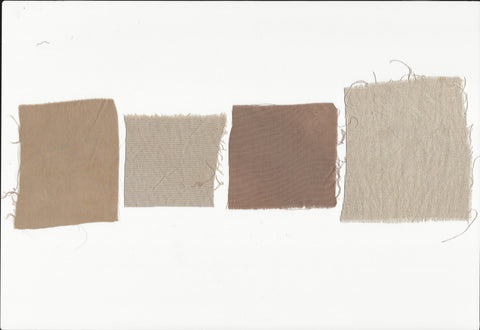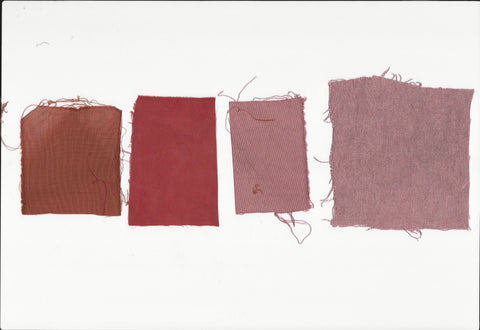We attended a workshop on natural dyeing at Casa Clementina, Pettinengo, Italy with Stefano Panconesis and his wife Sissi in 2019. It was a two day workshop focused on dyeing with natural dye materials. There were a lot of important pointers that came to our attention to perform the complete process. We also got to know about the history of natural dyeing and how synthetic dyes took over the market and the industry in just 200 years resulting in a drastic downfall of natural dyes.

While talking about the ingredients we got to know that there are 3 forms of Ingredients fresh, dry and extract.
- The fresh form is how we had shown you in our previous articles using directly from the fresh natural resources.
- The dry form is where the ingredients are collected and dried over a period of time.
- Extracts are pure powder or liquid form which is just the concentrated colour of the plant. Extract is the most pure colour form of natural dyes.
Now as the ingredients are used in 3 different forms, the quantity required to colour the textile also varies.
- Fresh form --> 100-200% ingredient
- Dry form --> 40-50% ingredient
- Extracts --> 4-5% ingredient
**Every quantity to be used is decided as per the Weight of Fabric (WOF).
The research that we did:
Below are the comparative results of the 4 ingredients we used - Logwood, Walnut Hulls, Madder Root/Rubbia and Weld. The process took place with 2 mordent preparations, alum (as shown in the left column) and iron (right column).
1. Logwood
Logwood (Haematoxylum campechianum) originates from the Yucatan region of Mexico and is naturalized throughout Central America and parts of the Caribbean.
Logwood yields a rich, deep purple which was used as a base or “bottom” for the desirable dark purple and black colors of European fashion and aristocracy. In the 18th century, nearly all black dyed cloth was colored from Logwood. With added iron, it's lightfastness increases and the color darkens to a near black.
(L to R) Logwood on Linen, cotton, wool and silk. 
(L to R) Logwood w/ Iron modification on Silk, linen, wool and cotton. 
2. Walnut Hulls
Walnut – Black walnut (Juglans nigra) is a common source of brown dye throughout North America. The fleshy hulls are full of tannin, juglone and other pigments are the primary source of the dye. Walnut hulls were used to dye hair, make inks and clothing and are also used in herbal medicine.
(L to R) Walnut Hulls on Linen, wool, cotton, silk.
(L to R) Walnut Hulls w/ iron modification on wool, cotton, silk, linen. 
Whole Madder Root – Rubia cordifolia from India. Produces very strong and rich reddish orange shades with multiple afterbaths. We soak the roots, grind or pulverize, then add fiber and simmer at low temperatures to develop the deep rich color. 100% weight can be used for deepest cranberry to garnet shades. A small amount of Citric Acid and Calcium Carbonate would allow you to get the richest shades the madder roots.
(L to R) Indian Madder on Wool, Silk, Cotton, Linen. 
(L to R) Indian Madder w/ iron modification on Silk, linen, wool, cotton. 
4. Weld
Weld (Reseda luteola) is the most light fast of the yellow dyes, used by ancient tapestry weavers in Central Asia, Turkey and Europe. Weld is the brightest and clearest yellow flower dye and in combination with iron creates a rich chartreuse, or overdyed with indigo is a clear lime green.
(L to R) Weld on Linen, wool, cotton, silk. 
(L to R) Weld w/ iron modification on Linen cotton, silk, wool. 
Another very interesting thing that we came across were "Corozo Buttons". Corozo is a 100% natural product which is similar in consistency to a hard resin. It is also referred as "vegetable ivory". It gives excellent durability and scratch resistance.

We mordanted and dyed these buttons in the same way as the textiles above.
Japanese Way of Natural Dyeing
We also got to know about the Japanese way of dyeing textiles naturally. So when it comes to natural dyeing, the Japanese do not believe in pre mordanting the textiles. They feel that the mordant adds a layer to the fabric and then the colour never really gets absorbed on the base textile but just that mordant layer. So instead of pre mordanting, they dip the textile in the dye bath first. After heating the textiles in the colour, they are dipped in the mordant solution without washing. Then again the textiles are dipped in the dye bath.
This process can be repeated as many times as you like till you reach your desired shade.

So, to put it all together, dyeing with dry materials is easier and less time consuming way of natural dyeing. It gives a great value of tones and shades and of course better light fastness. These plants have been used in centuries old paintings, fashion and textiles and we can see very evidently how well they have survived in various museums and collections from that era.
You can find some of these materials on my website as well! We have Indian Madder and walnut hulls on our supply store --> Natural dyes. Weld and Logwood are not available in India but you can find them online and import the through certified exporters.
Maybe you can try growing them in your own garden as well and you'll have not just naturally dyed wardrobe but an amazing textile garden as well!
Do share your opinions and results (if you try to do it yourself) :D !
Lots of Flowers,
Heena Agrima


